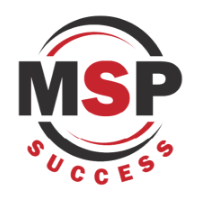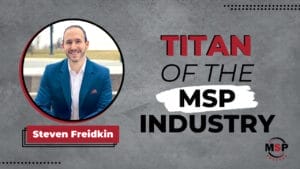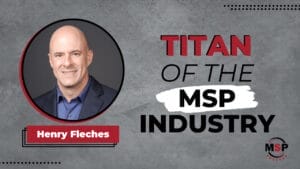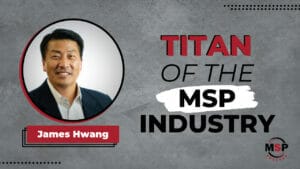Tom Glover, chief revenue officer of Responsive Technology Partners, tells MSP Success Magazine how he grew his company to $20 million in revenue and how small MSPs can find big opportunities to take their companies to the next level.
Note: This article is taken from a live interview and has been edited for clarity and length.
In 2007, Tom Glover founded his MSP, which grew to nearly $3 million in revenue overnight. But just as quickly, the tides turned, and Tom found himself back to $0. Over the next eight years, Tom slowly grew his company and eventually joined Technology Marketing Toolkit, transforming his marketing and sales strategy. When Tom hit $1 million in revenue, he sold his company and merged with another small MSP. In 2020, they brought on another equity partner and rebranded as Responsive Technology Partners. Today, Tom is the chief revenue officer for the company, which is trending to hit $20 million this year.
Robin Robins, founder of Big Red Media and MSP Success Magazine, spoke with Tom about the company’s recent growth, and Tom shared his thoughts on how smaller MSPs can maximize their growth by taking advantage of opportunities in compliance, finding innovative ways to attract and retain talent, and locking in mid-market SMB clients looking to outsource.
Robin Robins: You have an impressive comeback story. You started your MSP in 2007, but you had to regrow from scratch after some massive losses. Today, Responsive Technology Partners is about to hit $20 million in revenue. Tell me how you got to where you are today and your approach to growing the company.
Tom Glover: I started my company back in 2007. I grew it to $3 million overnight and dropped back down to almost zero overnight. Then, I spent the next eight years slowly growing before joining up with Technology Marketing Toolkit and really started marketing and all that good stuff. I sold my business when I had grown to about $1 million and merged with another MSP that was close to the same size, about $650,000. I took over as the CEO at that time, and then in 2020, we brought on another equity partner and rebranded the company as Responsive Technology Partners.
At that time, I ran everything for Georgia and loosely ran sales for the whole organization. Last year, we did a restructuring to adjust to our growth, and I stepped into the chief revenue officer role. Anything that deals with revenue, whether it’s looking at acquisitions, sales or marketing, I’m now running for the whole company. We’re headquartered in Metter, Georgia, but have 11 offices now across Virginia and Florida. Right now, we’re trending to be close to, if not just over, $20 million this year in revenue.
Robin: You’re still growing too. Are you making acquisitions? What’s your approach to growing the company?
Tom: As a large company, we face problems now that never entered our minds at $600,000 a year. Back then, it was how do we make sure we’re hitting payroll? Now it’s all about what turns can we make that will take the company to the next level?
There’s a lot of activity in the acquisition world, but we’ve been really picky in who we acquire. We’re still looking for the right fit. It’s got to be fitting both geographically and as a cultural fit within the company. Also, the new growth challenges we’re looking at for the company are about what’s next geographically. Are we expanding our geographic base or going deeper within our existing geographies?
Robin: Our data shows the average growth rate for MSPs is about 23%. But even though MSPs are growing their revenue, their profitability is stagnant or declining. There are a lot of challenges like inflation, labor shortages and increasing competition they are dealing with. What are the biggest threats you’ve had to navigate, and how are you doing it?
Tom: We’ve had issues with poaching on the labor side. It’s not just MSPs you’re fighting with. You’re dealing with the Microsofts and Ciscos of the world and manufacturing facilities and other large industries. They’re fighting with the same challenges we are, and we compete with them.
One big benefit we have is that most technical people I know love a challenge; they love variety. You don’t get that as much in the corporate world. Whatever the systems or platforms they use, you’re stuck with. If you can’t keep someone challenged and engaged – even if you’re paying them the same thing as larger companies – they will start looking for other opportunities. That’s a benefit we have as an MSP that works in 70 industries. There’s never a dull moment, and that appeals to a lot of people. That’s helped us to hold on to more mature technicians and engineers, but it’s a tough market still. Even though you see these significant layoffs happening at Microsoft and Twitter, they’re not the resources we’re going after. Those are very scarce.
Robin: When you get into certain trades or skill sets, there’s a lot of fighting for talent. You’re giving your employees variety and challenge, but are you giving them pay raises? What else are you doing to keep talent?
Tom: One innovative thing we did that’s helped us on several fronts is roll out a new profit-sharing plan. We did this in January, and it’s structured so employees can get immediate results from it and see exactly where their impact can be. Often, profit-sharing plans roll in at the end of the year, and it’s a nebulous number. They don’t know how it’s calculated or if it’s a fixed percentage. It doesn’t quite incentivize people. In just the first month of rolling out our plan, we saw a one-point increase in profitability.
What’s more exciting is the conversation we hear around the offices, where peers hold each other accountable to tow their weight and go the extra mile. As a C-level executive, I’m used to having these conversations, but when you hear your engineers and salespeople doing it, it creates a lot of excitement in the office. It’s also a proven way to attract talent. When I have a conversation with a new sales rep, and we go over the standard sales comp plan and say, “Oh, by the way, let me tell you about this profit-sharing plan that gives you the capability of earning up to 10% to 12% more of your salary at the end of the year,” it gets their attention.
One big problem is that many small MSPs feel threatened by sharing profit data because they worry employees will think they’re making that much more. But it opens a great conversation to say it’s not quite that. You’ve got these people who invested money in it, and if you invest money in a stock, don’t you want a return on that? We’ve seen nothing negative with opening that conversation up and being very transparent.
Robin: A lot of vendors and MSPs are talking about raising prices right now because of inflation. How are you handling that?
Tom: We did a price increase in October and generated another $60,000 a month or so. It got us back to parity, but it didn’t do a whole lot with completely increasing profitability. It did some, but a lot of that was catching up with rising labor costs and business costs. We’re going to look at this every October, and most likely we’ll see another increase at the end of this year. But it’s not just increasing the price for your existing customers – it’s raising the pricing for new customers that are coming on too.
We’re also negotiating prices with vendors. That’s one of the benefits of size. When I’m shopping 12,000 endpoints, it’s a different conversation than shopping 1,000 endpoints. Sometimes we’re buying up, we’re anticipating the growth and committing to a larger number to lower our overall cost, which increases profit on the next set of customers.
Robin: What are some other challenges MSPs are dealing with right now?
Tom: The economy is still something we’re all worried about, and honestly, looking at the markets I’m in, we have yet to see the impact of it. I think there was such a pent-up demand out there that we’re still catching up with the backlog and will be for the next six months. But at some point, that’s going to run out. If we don’t get the economy under control, then there could be a downturn.
But the great thing about being an MSP is that we get all kinds of project work when the economy is good. It’s also great when the economy starts going down if you’re in the upper SMB to mid-market company, because those clients start looking to cut expenses, and outsourcing is one way they do it. We get an opportunity to pick up more work there if we’re marketing in that space. And we’ve had those conversations for several years now around managed security. That’s been a big seller for us where we could come in and be in a position to help. Bring expertise that their in-house staff didn’t have, and they couldn’t afford really to staff long-term. But those relationships tend to have an opportunity to net more as they look at cutting expenses we can pick up. You know, we’re already in there. We know their environment and can help when Joe leaves. You don’t have to rehire.
Robin: You mentioned taking advantage of clients looking to outsource. When you look ahead, what other opportunities do you see for MSPs?
Tom: Compliance, I think, is the biggest one here. We’ve always played in that space. Back in 2018, when I started putting my USP together for the first time, I talked about complexity. We specialize in companies that have complexity, and one of those components is always compliance. You have things like regulatory compliance – HIPAA, SOX and ISO compliance. The insurance world, though, has turned that upside down. Now everybody has compliance. You want to be insured and covered against cyber-attacks or losses in any way. There’s a rigid set of compliance mandates that you’ve got to be in touch with, and that’s driving more business for us right now than anything else.
We work with several brokers, and when they get uninsurable clients, they come to us and go, “Okay, what can you do to get them up to par where they can answer this questionnaire and become insurable?” They’re also scaring the others that are starting to answer the question and go, “Are you sure that’s really a yes?” They’ll ask, “Do you have two-factor authentication?” “Well, yeah, every time I log in to Office 365, it’s that way.” “Okay, but what about your payroll system? What about this system? What about that system?” Suddenly people start doubting, and that opens the door for us. I tell my sales guys, please ask customers, “When’s your insurance renewal? Let us help you answer that questionnaire.” Because every time they need to make an explanation to answer a question, that’s an opportunity for a sale.
Another opportunity is infrastructure. Looking at our markets, Georgia, for example, is very hot right now. We just had an announcement of a huge Hyundai plant that’s coming to south Georgia. People are buying up real estate left and right, and there’s all kinds of construction going on. Whenever you can be in an area that’s got that kind of activity, that’s not tied to the economy because they’ve already made the bet, there’s a ton of opportunity. Last week I had a meeting with a local construction company that is doing a lot. Local architects help with building design and things like that, and they will be tapped into what’s going on. Being in touch with local governments, and just keeping your ear to the ground and getting out there to find out who’s coming to town and start those conversations.
Robin: Many of our member MSPs at Technology Marketing Toolkit are hovering around $1 million in revenue but have bigger aspirations. What’s your advice to smaller MSPs that are trying to grow? Tom: The biggest thing I would tell smaller MSPs is to look at those opportunities that both sell within their existing customers and enhance their value to other customers out there. Take an insurance questionnaire and look through it. Answer the questions and ask yourself, “Can I provide this?” As an MSP, when you can’t answer “Yes,” then somebody else can. That always increases the risk for someone to come in and wedge you out because they were able to help get them to the next level when it comes to their insurance. If there’s a “No,” put it on your road map to add. It increases revenue and gives you an opportunity to get into many more places.






